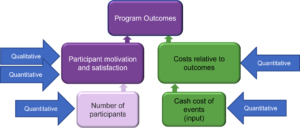 Measuring the success of alumni events is crucial to understanding their impact, identifying areas for improvement, and tailoring future engagement strategies. It is always the time to think about measuring success – even as you start to plan an event. If you think about what outcomes you want from the event, then you also need to think about how to measure those outcomes. Here are some key metrics and methods you can use to measure the success of alumni events:
Measuring the success of alumni events is crucial to understanding their impact, identifying areas for improvement, and tailoring future engagement strategies. It is always the time to think about measuring success – even as you start to plan an event. If you think about what outcomes you want from the event, then you also need to think about how to measure those outcomes. Here are some key metrics and methods you can use to measure the success of alumni events:
- Attendance and Participation Rates: Measure the number of attendees compared to the expected turnout. High or capacity attendance indicates strong interest and engagement.
- Feedback Surveys: Collect post-event feedback through surveys to gauge attendees’ satisfaction, gather suggestions for improvement, and understand what aspects of the event resonated most.
- Net Promoter Score (NPS): Ask attendees how likely they are to recommend the event to others. This can help assess overall satisfaction and whether attendees are willing to promote the event to their peers.
- Social Media Engagement: Track engagement metrics on social media platforms, including likes, shares, comments, and event-specific hashtags, to assess the event’s online reach and resonance.
- Return Attendance Rate: Track how many attendees return to attend similar subsequent events. Consistent attendance indicates that the events are meeting attendees’ expectations.
- Participant Demographics: Analyze the demographics of event participants to ensure that your events are inclusive and representative of your alumni community.
- Follow-Up Engagement: Monitor subsequent engagement from attendees. Are they more active on your alumni platform or social media channels? Are they participating in other engagement initiatives?
- Alumni Donations: Track any increase in donations or contributions following an event, as engaged and satisfied alumni may be more likely to support the institution financially.
- Media Coverage and Public Relations: Measure the event’s coverage in media outlets or on social media platforms to gauge its impact on the institution’s reputation.
- New Alumni Connections: Assess the number of new connections or relationships formed among alumni during the event. This indicates successful networking opportunities.
- Post-Event Content Engagement: Share follow-up content such as event photos, videos, or articles. Measure engagement with this content to extend the event’s impact.
- ROI Calculation: Compare the costs of organizing the event (venue, catering, marketing, etc.) to the benefits, such as increased engagement, donations, or positive media coverage.
- Alumni Testimonials and Stories: Collect testimonials or stories from attendees about their experiences at the event and share these on your platforms.
- Post-Event Interviews: Conduct one-on-one interviews with a sample of attendees to gain deeper insights into their perceptions of the event and its impact on them.
- Benchmarking: Compare event metrics to previous events or similar events held by other institutions to gain context and insights into what is considered successful.
Remember that the metrics you choose to measure will depend on the goals and objectives of each specific event. It’s important to establish clear goals beforehand and select metrics that align with those goals. By analyzing these metrics, you can refine your event planning and alumni engagement strategies for more successful outcomes in the future.
Read more articles in the Alumni Relations Transformations Series at AlmaShines or the Impactrics Resources area.




